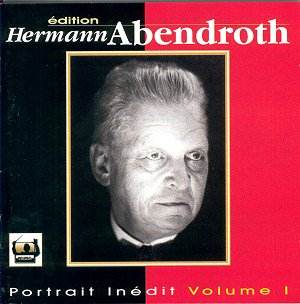Abendroth admirers are well served
by this slimline double CD set from Tahra, which ranges
chronologically from Gluck to Mendelssohn and in terms of recording
dates from 1944 to 1956, just months before the conductor’s death. The
classicist and romantic Abendroth are thus on show in performances that
marshal his characteristic qualities. The three symphonies and four
overtures offer a good conspectus of his discernment in this repertoire.
Whilst one couldn’t truly claim that these readings elevate Abendroth
to the most exalted level of twentieth century conductors there is much
that is laudable. In one performance, the wartime Gluck, we catch a
glimpse of the magnetic power that can lift a performance. His wartime
performances have, not unsurprisingly perhaps, a sense of frequently
overwhelming engagement that is sometimes missing from both the electrically
recorded symphonies of the late 1920s and early 1930s and from his post-War
discs.
It is the Gluck overture to Iphigénie en Aulide that opens
the set, a performance made with the Berlin Philharmonic – their only
appearance here – in September 1944. Strongly subjective, romantic,
with strings that are thick and powerful this is a hypnotic reading.
Certainly some may find it – even in contemporary terms – vastly inflated
and glutinous but it is also wildly exciting, drenched in effulgent
lyricism and sporting proto-Beethovenian brass to stunning lyrico-dramatic
effect. We jump to 1953 for a Leipzig Haydn Drumroll Symphony.
The recording, quite close, highlights the dramatic timpani roll before
we hear Abendroth’s rather lugubrious and saturnine orchestral introduction.
Comparison with the almost contemporaneous Beecham commercial disc (CBS
1951) shows that Abendroth keeps the tempo moving rather more but is
less precise with his wind chording, Beecham allowing a greater sense
of space to emerge and encouraging phrasing of more obvious charm. Abendroth
however is still full of light-heartedness and spirit; this is no po-faced
reading. In the Andante he is slower than Beecham who very slightly
lengthens the basses’ note values the better to develop string phrasing;
Abendroth’s leader is full of character, if occasionally very slightly
fallible, in his long solo here. The Minuetto is a big boned affair
in Abendroth’s hands, solid and weighty and much slower than Beecham’s
more nimble and spirited traversal whilst in the Finale both men take
the same tempo and Abendroth is full of eruptive fissures but also genial
fire. The Mozart Symphony dates from two years later but the sound is
very much more muffled and disappointingly so in comparison with the
perfectly acceptable 1951 Haydn. The lower frequencies suffer in particular
and this is bad for the indistinct bass line and their entries. The
performance is good but not as good as the Haydn. Sensible tempi inform
the first movement with strongly characterised material and some emphatic
phrasing. The slow movement is really quite slow with expressive string
playing and elegant woodwind contributions whilst the Minuet is rather
solid in the portly rococo manner. However there’s still plenty of opportunity
for rhythmic pointing and for once the recording allows us to hear the
well-filled bass line. I liked the finale; a good tempo, fine articulation,
no exaggeration. The first disc ends with a January 1956 performance
of the overture to Oberon. Nuanced fillips drive the score with a sense
of incipient drama and Abendroth’s rubati, romanticised though also
highly pronounced, add another layer of dramatic weight, especially
to the central, lyric section.
The second disc opens with two Mendelssohn overtures, expected
Leipzig fare, and taped a year apart. The overture to
A Midsummer Night’s Dream dates from 1950 and is in reasonable sound.
The performance is playful with fine chording and of eloquent and unforced
musicality. The Hebrides was set down almost a year earlier; strong, rugged,
powerful, not over-scaled, neither too fast nor unfeeling, a good solid
traversal. Schubert’s Ninth ends the set, a September 1955 reading.
Here Abendroth is far more personalised than in the other performances
that grace the set, his strongly etched and powerful first movement
containing inflections that set it apart. There is tremendous drive
to his conducting, real passion, a dramatic sense of involvement and
also a sometimes disruptive idiosyncrasy that won’t be to all tastes.
There’s no doubting its drama or spiritual fire though.
The booklet reprints an autobiographical sketch by Abendroth
originally printed in ‘The Artists Chatter’, a German book published
in 1940 – the first time it has apparently been translated into English
(the booklet notes are in French and English). There is also an interview
with Abendroth pupil Günther Herbig and with
Hans Schippel, a first violin in the Leipzig Radio Orchestra under Abendroth.
All three are unusually insightful. A genuinely enjoyable
and musically satisfying set of discs.
Jonathan Woolf
